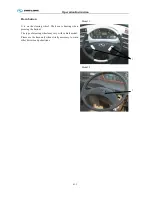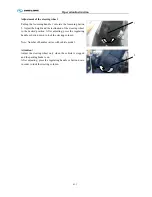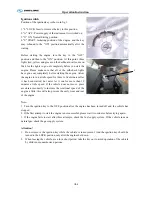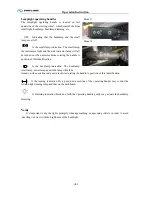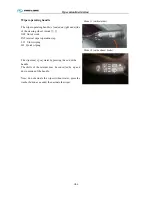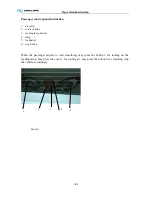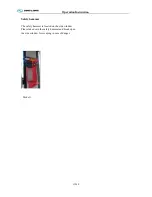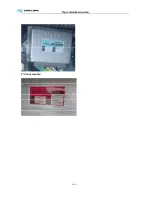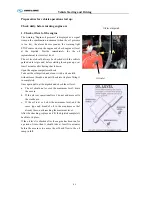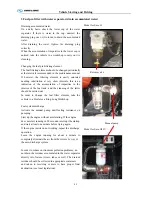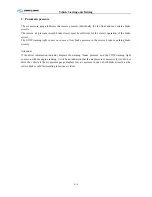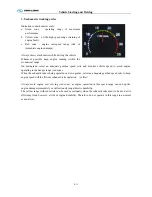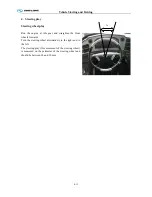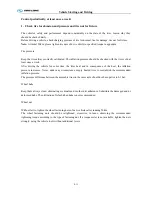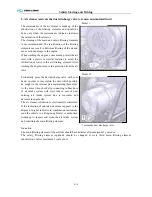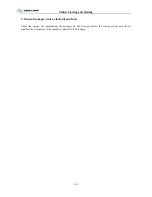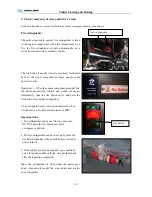
Vehicle Starting and Driving
S-2
2 Check level of the coolant
The coolant level is automatically monitored.
If coolant level gets too low
,
the digital indicator
displays a driver information on the combination
instrument. In this case, park vehicle in a safe place as
traffic conditions permit, stop engine and visually
check the coolant level.
Check the coolant level only when the engine doesn’t
work and its temperature is below 50
℃
.
The anti-freezing rust-inhibiting engine coolant level
can be observed from the observe pipe.
The coolant level should be between the maximum
level (MAX.) and minimum (MIN.) level indicators in
the compensation tank.
If it is necessary to add coolant to the system:
a.
Place the heating system command in the position
of maximum heating potency.
b.
Add the coolant to the system up until the
maximum level indication. Only use coolant
which is recommended.
c.
The compensation tank cover should not be
opened when temperature of the coolant is still
high to avoid being scalded Place the lid on the
system and turn it to the limit.
d.
Pressure valve of the compensation tank should be
opened when adding the coolant to eliminate air in
coolant pipeline of the diesel engine.
e.
Run the engine for a short time at varied rotations.
f.
Stop the engine and check the coolant level.
If necessary add more coolant to the system
Anti-freeze and antirust solution (mixture of glycol and water) should be added to cooling system from
time to time to avoid sediment, frost, oxidation and increase boiling point.
Note: When adding coolant, please choose the same model to avoid sediment. If coolant is degenerative,
replace it immediately.
Coolant specification as shown below: users should choose products produced by normal factories
according to requirement
Observe pipe
Observe pipe
Summary of Contents for XMQ6127 series
Page 18: ...Operation Instruction CI 1 Figure 17 Set MotPPR Figure 18 Clear Trip A Figure 19 Clear Trip B...
Page 32: ...Operation Instruction P A 1 2 Control panel operation...
Page 33: ...Operation Instruction P A 1...
Page 34: ...Operation Instruction P A 1...
Page 35: ...Operation Instruction P A 1...
Page 36: ...Operation Instruction P A 1...
Page 41: ...Operation Instruction 0 G 1 1 1 2 2 Pushbutton Settings...
Page 42: ...Operation Instruction 0 G 1 1 2 Starting the Engine 1 3 Selecting the Gear...
Page 43: ...Operation Instruction 0 G 1 1 4 Setting Off 1 5 Driving Ranges...
Page 44: ...Operation Instruction 0 G 1 1 5 1 Downhill Travel 1 5 2 Downhill Travel 1 5 3 Kickdown...
Page 46: ...Operation Instruction 0 G 1 1 6 Stopping Parking...
Page 51: ...Operation Instruction 0 G 1 1 11 1 Limp Home Mode 1 12 Auxiliary Control Unit...
Page 52: ...Operation Instruction 0 G 1 1 12 1 Operating Instructions for the Auxiliary Control Unit...
Page 53: ...Operation Instruction 0 AB 1 WABCO ABS BASIC INTRODUCTION...
Page 54: ...Operation Instruction 0 AB 1...
Page 55: ...Operation Instruction 0 AB 1...
Page 56: ...Operation Instruction 0 AB 1...
Page 57: ...Operation Instruction 0 AB 1...
Page 58: ...Operation Instruction 0 EC 1 ECAS System Introduction 1 System introduction...
Page 59: ...Operation Instruction 0 EC 1 3 System function...
Page 60: ...Operation Instruction 0 EC 1...
Page 77: ...Operation Instruction 0 E 1 CAN bus module...
Page 158: ...Appendix A 4 Air braking schematic diagram...
Page 159: ...A 5 Electric schematic diagram of the complete vehicle 1...
Page 160: ...A 6 Electric schematic diagram of the complete vehicle 2...
Page 161: ...A 7 Electric schematic diagram of the complete vehicle 3...
Page 162: ...A 8 Electric schematic diagram of the complete vehicle 4...



